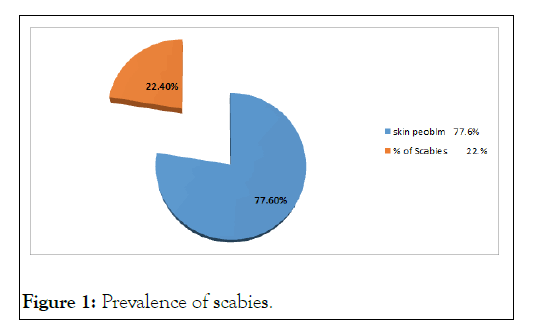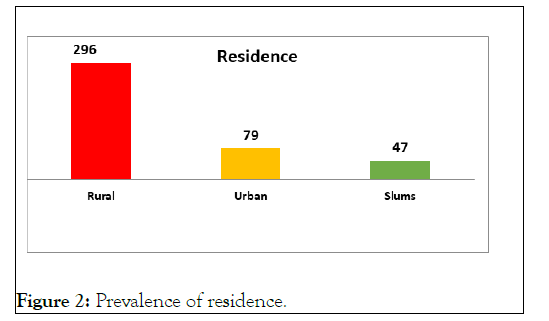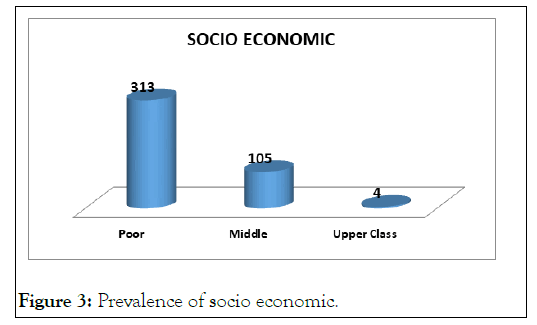Journal of Clinical & Experimental Dermatology Research
Open Access
ISSN: 2155-9554
ISSN: 2155-9554
Research Article - (2021)
Introduction: Scabies is a neglected tropical public health problem around the world. It is caused by the Sarcoptes Scabiei mite that infested under the skin. The prevalence has been noted as per year is 300 million patients.
Objectives: To determine the frequency of Scabies at PMCH Nawabshah.
Methods: A cross-sectional study has been carried out on 422 patients at people’s medical hospital Nawabshah at outpatients department of dermatology. The technique of sampling was convenience. A structured questionnaire has been used for data collection and analysis. All data has been collected by researcher on diagnosed cases of scabies by skin specialists.
Results: The study is showing prevalence 22.4% among skin problem persons. The mean age of participant 60.2. Scabies can occur at any stage of life. Comparison of male and female individuals as 6610 (48%) and 6595 (52%). The marital status of the participants as; married, widower, divorced and widow was 260 (66.3%), 118 (27.9%), 2 (0.47%), 1 (0.23%) and 21 (4.97%) respectively and high rate found in lower economic condition.
Conclusion: The prevalence of scabies at people’s medical hospital Nawabshah is 22.4 the prevalence of scabies high in developing countries and this found prominent in areas. The high ratio of scabies is associate with limited resources of basic life. Scabies seems to be neglected tropical problem of health.
Scabies; Prevalence; Socio-economic; Sindh; Pakistan
The worldwide prevalence has been estimated about 300 million cases yearly. The International Alliance for the Control of Scabies (IACS) was started in 2012 and alliance has reviewed 70 researchers with the help of public health experts in more than 15 countries on scabies [1]. The endemic of scabies is presenting highest prevalence rates and outbreaks in tropical region among developing countries. Many tropical and subtropical locations such as Africa, Egypt, Central and South America, North and Central Australia, Caribbean Island, India and Southeast Asia. Contagious skin infestation usually required two to six weeks before signs and symptoms appeared. The commonest symptoms are itching and rash the most affected body areas, such as between the fingers, wrist, axilla, groin, under the breast and other body folds [2]. The rashes of scabies looks likes pimples occasionally tiny mites can be seen by light microscope. The disease is most often spread due to person to person like sex, overcrowded rooms, unhygienic condition, clothing, and fomites. Scabies is a commonest disease seen mostly in the developing countries peaks in winter season throughout the world but often seen mostly in poor communities and overcrowded areas [3]. Endemics of scabies in the tropical countries without significant fluctuations reported in the study and suggested that the role of herd immunity is more limited than previous thoughts. Neighbor country Iraq have a prevalence of scabies was in range between 11.3% to 16.4% and the above mentioned studies shows that overcrowding, poor public health, sharing of clothes, sharing on towels, sleeping space and unhygienic practices are mostly risk factors of scabies are noted. The required data for scabies during 2009 is 86076 patients in which a total 9828 (11.4%) patients were affected with scabies in Iraq [4].
The prevalence of scabies has been reported as 10% in the under developing countries the most risk factors of spreading are overcrowding, poor hygiene, population density, personal hygiene and less room facilities and rural living setting are more risk of scabies in the under developing world. A study was conducted at karachi has shown the prevalence of scabies was 70.6% among OPD skin disease patients at Jinnah medical hospital and Agha Khan University hospital in relation to disease burden and risk factors of scabies [5]. The prevalence and complication of scabies made that a major public health problem in the developing world and the burden of disease seen among the women and children those living in poor areas and overcrowded tropical regions. The purpose of the study was to determine the scabies prevalence in PMCH Nawab shah (OPD) and related factors that influence the scabies in the region. Study will also helpful to knowing the prevalence difference among the cities.
Objective
To determine the frequency of scabies at PMCH Nawabshah.
Significant and important role of nurse
Nurses play а crucial role in the quality of care improvement, which provides patients education and support. At the same time, the nurse can provide health promotion and psychosocial services include assessment, health education, counseling and appropriate referral [6]. Operational definition: Scabies is a feeling of itching at night and areas involved are web of fingers, axilla, abdominal lining, under the breast and genital organs. Rural area: Far from main city and having fewer basic facilities likes villages. Urban area: City having most of the basic facilities like water supply, drainage, electricity and health facilities. Slums area: The area within the city but having congested streets and overcrowding and less facilities then center of city [7].
Study setting
The study has been conducted at outdoor patients in skin OPD. Peoples medical hospital Nawabshah (Teaching hospital Nawabshah also covers the nearby peripheries of district).
Study population
All the patients of scabies that visited to OPD and diagnosed by skin specialist and only scabies patients are enrolled instead of non-patients in the study.
Duration of study
The study is completed within six months from July 2017 to 18th December 2017. The data entered in SPSS 20.0 software and analysis was done and applying appropriate applications.
Study design: Cross sectional study
Sample size: Sample calculated soft sample calculator as error 5% with confidence interval 95% and 1.2 million population. But we took 422 as a sample.
Sampling technique: Convenience sampling method was used.
Sampling: Those they are diagnosed scabies have been added in sampling.
Including criteria: All the patients of skin OPD are enrolled and data collected form scabies patients.
Ethical consideration: Informed verbal consent has been taken at the time of interview. The confidentiality about their particulars is kept secret [8].
Exclusion criteria: Patients are excluded those are not willing to participate in study and having other skin problems are not eligible for participation.
Data collection procedure: After approval of Synopsis from Ethical Review Committee (SRC PUMHS) study is conducted at outdoor patients of skin OPD department Nawabshah (SBA). After taking informed verbal consent from respondents the data is collected and enrolled by criteria by researcher himself on predesigned questionnaire [9].
Data analysis procedure: After entered data from respondent analysis carried out by SPSS version 20.0, age, gender and SES variables were presented in percentage. Data is presented in graph and charts. P value will be taken as 0.05 and 95% confidence interval.
The mean age of the participants 60.2. The number of skin problems except scabies patients during the six months from July to December at 56229 females was 34525 at 61.4% and male were 21704 as 38.6% [10]. The number of scabies in patients was 12705 (22.6%). The age of the participants from 0 to 1 year of age was 12 (2.8%), 1.1 to 5 years 34 (8%), 5.1 to 15 years 29 (6.8%), 15.1 to 15 years of age 60 (14.1%), 25.1 to 35 years 104 (24.6%), 35.1 to 45 years 75 (17.7) and 108 (25.5 %) were those who above 45 years participated.
The comparison of male and female individuals as 6610 (48%) and 6595 (52%). The marital status of the participants as; married, un-married, widower, divorced and widow was 260 (66.3%), 118 (27.9%), 2 (0.47%), 1 (0.23%) and 21 (4.97%) respectively. Moreover, the area of resident those participants in the study, there are 3 areas as rural 70.2% and urban 18.7% also slums represent as 11.1%, so the number of rural patients higher than other areas. This study results shows the socio-economic rating of participants as, poor class were 313 (74.1%), middle 105 (24.8%) and 4 (0.94%) representing the upper class (Table 1) [11].
| Age in years | n=1 | Percentage |
|---|---|---|
| 0-1.0 | 12 | 2.8 |
| 1.1-5 | 34 | 8 |
| 5.1-15 | 29 | 6.8 |
| 15.1-25 | 60 | 14.1 |
| 25.1-35 | 104 | 24.6 |
| 35.1-45 | 75 | 17.7 |
| ≥ 45.1 | 108 | 25.5 |
| Total | 422 | 100 |
Table 1: Age of participant.
A group of age from 15 to 45 and above having more prevalence of scabies as 56.3% is affected with scabies and lowest value in infants as 2.9% (Table 1). Married as 66.4% and lowest value is divorced persons as 0.2%. The risk of spreading of scabies due to bad sharing is strongly exists in the study (Table 2).
| Marital status | n=1 | Percentage |
|---|---|---|
| Married | 280 | 66.4 |
| Unmarried | 118 | 28 |
| Widower | 2 | 0.5 |
| Divorced | 1 | 0.2 |
| Widow | 21 | 5 |
Table 2: Marital status.
The study is showing 22.4% scabies patients among skin problem persons with in the study duration (Figure 1).

Figure 1: Prevalence of scabies.
Highest participation from the rural area. So the persons belong to rural areas in majority (Figure 2).

Figure 2: Prevalence of residence.
The number of poor 74.2% that is showing the higher number of poor in the study is more than others (Figure 3).

Figure 3: Prevalence of socio economic.
In this study there is no any sound difference seen between male and female ration which is 48% and 52%, comparing a retrospective study shown the prevalence of scabies in among female as compare to male as 56.5 and 43.5%. To find the relation of socio-economic condition, the participant's condition arranged in three places according to their income status; poor class. These conditions set as their monthly [11]. For poor having income of less than 15000, middle having less than 40000 and upper more than 40000. This study finds a good relationship which the level of income of the victim of scabies. In 74.2% who were infected from 24.9% were those who from middle and 0.9% from the upper class. A study is conducted in haripur, shown also shown a good relation of scabies with the level of income. Socio-economic condition has worse contribution for scabies which is 13.18% in poor, 7.1% in middle and 5.1% in the upper class [12]. The married as 66.4% and lowest value is divorced persons as 0.2%. This study also that risk of spreading of scabies due to bad sharing is strongly exists in the study, few other the high ratio in married and sharing of bed strongly associated the infection of scabies. In this study the residential area divided into rural, urban and slum areas. The 70% infected cases from rural areas, 18.7% were urban and 11.1% were from the slum areas. In irian there is situation is quite differing from here, the cases investigated as 82.5% and 17.5% from urban and rural areas.
The prevalence of scabies high in developing countries and this found prominent in areas. The high ratio of scabies with limited resources of basic life. Scabies seems to be neglected tropical problem of health. The number of married people more prone to scabies; showing strong risk of sexually transmission, family members of participant and living style like. The population is participating from rural areas with peoples in the study were infected so the sense of hygiene is controversial. Their to be special attention.
Health education about scabies and precaution from the disease must be done at rural make a proper strong plane to decrease and in the region. Further, this study rules out the prevalence of scabies, their more study should be conducted to find the risk and association of scabies among age.
There is no conflict of interest seen during the time of study.
Citation: Khoso AH, Nadeem K, Chacher B, Pirzada BA, Bashir S, Khan J, et al. (2021) Prevalence of Scabies at Dermatology Department PMCH Hospital Nawabshah. J Clin Exp Dermatol Res. S9:570.
Received: 16-Jul-2021 Accepted: 09-Aug-2021 Published: 16-Aug-2021 , DOI: 10.35248/2155-9554.21.s9.570
Copyright: © 2021 Khoso AH, et al. This is an open-access article distributed under the terms of the Creative Commons Attribution License, which permits unrestricted use, distribution, and reproduction in any medium, provided the original author and source are credited.